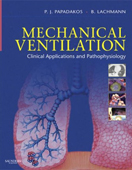One of the key tools in effectively managing critical illness is the
use of mechanical ventilator support. This essential text helps you
navigate this rapidly evolving technology and understand the latest
research and treatment modalities. A deeper understanding of the
effects of mechanical ventilation will enable you to optimize patient
outcomes while reducing the risk of trauma to the lungs and other
organ systems.
----------------------------------------------------------------------
----------
목차
차 례
I. Understanding the Evidence
1.Diagnostic Accuracy of Physical Findings
2.Using the Tables in this Book
3.Reliability of Physical Findings
II. General Appearance and Selected Medical Disorders
4.Stance and Gait
5.Jaundice and Cirrhosis
6.Cyanosis
7.Anemia
8.Hypovolemia
9.Protein-Energy Malnutrition and Weight Loss
10.Obesity
11.Cushing?셲 Syndrome
12.Lymphadenopathy
III. Vital Signs
13.Pulse Rate and Contour
14.Abnormalities of Pulse Rhythm
15.Blood Pressure
16.Temperature
17.Respiratory Rate and Abnormal Breathing Patterns
18.Pulse Oximetry
19.Prognosis in Various Medical Conditions
IV. Head and Neck
20.The Pupils
21.Diabetic Retinopathy
22.Hearing
23.The Thyroid and Its Disorders
24.Meninges
V. The Lungs
25.Inspection of the Chest
26.Palpation and Percussion of the Chest
27.Auscultation of the Lungs
28.Ancillary Tests
VI. Selected Pulmonary Disorders
29.Pneumonia
30.Chronic Obstructive Lung Disease
31.Pulmonary Embolism
VII. The Heart
32.Inspection of the Neck Veins
33.Percussion of the Heart
34.Palpation of the Heart
35.Auscultation of the Heart: General Principles
36.The First and Second Heart Sounds
37.The Third and Fourth Heart Sounds
38.Miscellaneous Heart Sounds
39.Heart Murmurs: General Principles
VIII. Selected Cardiac Disorders
40.Aortic Stenosis
41.AorticRegurgitation
42.Miscellaneous Heart Murmurs
43.Coronary Artery Disease
44.Disorders of the Pericardium
45.Congestive Heart Failure
IX. Abdomen
46.Inspection of the Abdomen
47.Palpation and Percussion of the Abdomen
48.Abdominal Pain and Tenderness
49.Auscultation of the Abdomen
X. Extremities
50.Peripheral Vascular Disease
51.The Diabetic Foot
52.Edema and Deep Vein Thrombosis
53.Selected Musculoskeletal Disorders
XI. Neurologic Examination
54.Visual Field Testing
55.Cranial Nerves
56.Examination of the Motor System: Approach to Weakness
57.Examination of the Sensory System
58.Examination of the Reflexes
59.Disorders of the Nerve Roots, Plexi, and Peripheral Nerves
60.Coordination and Cerebellar Testing
61.Examination of Hysterial Neurologic Disorders
XII. Selected Neurologic Disorders
62.Diplopia
63.Dementia and Mental Status Examination
64.Coma
65.Parkinson?셲 Disease
XIII. Likelihood Ratios and their Confident Intervals
66.Likelihood Ratios and their Confidence Intervals*
* This is a giant Table that displays the confidence intervals for
all likelihood ratios presented in the entire book ??a key feature of
the book and a really handy tool!
Index


